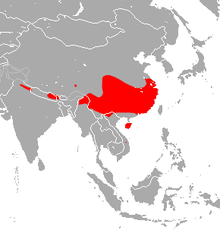中华菊头蝠
中华菊头蝠(学名:Rhinolophus sinicus)是翼手目菊头蝠科的一种蝙蝠,分布于中国南方、印度、尼泊尔、越南等地[2],过去一度被视为鲁氏菊头蝠的华东亚种(Rhinolophus rouxii sinicus)。近年来在染色体、形态方面研究,表明其与鲁氏菊头蝠有很大的差异,因而被提升为一独立种[3][4]。
| 中华菊头蝠 | |
|---|---|

| |
| 科学分类 | |
| 界: | 动物界 Animalia |
| 门: | 脊索动物门 Chordata |
| 纲: | 哺乳纲 Mammalia |
| 目: | 翼手目 Chiroptera |
| 科: | 菊头蝠科 Rhinolophidae |
| 属: | 菊头蝠属 Rhinolophus |
| 种: | 中华菊头蝠 R. sinicus
|
| 二名法 | |
| Rhinolophus sinicus K. Andersen,1905
| |

| |
| 中华菊头蝠分布区域 | |
其种加词“Sinicus”意为“中华的”。
外型 编辑
中华菊头蝠的前肢长4.3至5.6公分,耳长1.5至2公分,尾长2.1至3公分,为体型中等的菊头蝠,背侧的毛有两色,基部为棕色至白色,顶端1/3则为红棕色;腹侧的毛色较背侧淡。本种与鲁氏菊头蝠外型相似但翅膀较其稍长,与托氏菊头蝠形似但体型稍大[5]。
生态 编辑
中华菊头蝠为社会性动物,一般栖息于洞窟中[6],其群体可能由数只至数百只蝙蝠组成,繁殖季时怀孕、哺乳中的雌蝠会组成生殖群集[5]。中国洞蛭属的山蛭在洞窟中吸取中华菊头蝠等数种蝙蝠的血为食[7]。
冠状病毒宿主 编辑
2005年香港大学的研究人员就在中华菊头蝠身上发现与SARS-CoV相似的病毒株(SARSr-CoV)HKU3[8][9],2013年又有WIV1和SHC014两个SARSr-CoV病毒株在中华菊头蝠样本中发现[10],香港大学医学院传染病学教授袁国勇称,SARS病毒的天然宿主为中华菊头蝠,而果子狸只是SARS病毒(果子狸SARS冠状病毒)的中间宿主[11]。2015年美国北卡罗来纳州大学的拉尔夫·S·巴里克与武汉病毒研究所的石正丽实验室合作,以重组病毒实验发现SHC014病毒有感染人类的潜力,研究人员指新病毒致病性高,不过是否会像SARS般人传人仍需更多研究阐明[12]。2016年,石正丽实验室在云南的中华菊头蝠中发现另一SARSr-CoV病毒株WIV16,全基因组序列与SARS-CoV的相似度为96%[13]。
2018年4月,石正丽实验室发表了提出感染猪只的新型冠状病毒猪急性腹泻综合征冠状病毒(SADS-CoV),可能源自感染中华菊头蝠的菊头蝠冠状病毒HKU2[14]。
参考资料 编辑
- ^ Sun, K. Rhinolophus sinicus. The IUCN Red List of Threatened Species. 2019, 2019: e.T41529A22005184.
- ^ Filatov, Dmitry A.; Mao, Xiuguang; He, Guimei; Zhang, Junpeng; Rossiter, Stephen J.; Zhang, Shuyi. Lineage Divergence and Historical Gene Flow in the Chinese Horseshoe Bat (Rhinolophus sinicus). PLOS ONE. 2013, 8 (2): e56786. Bibcode:2013PLoSO...856786M. ISSN 1932-6203. PMC 3581519 . PMID 23451086. doi:10.1371/journal.pone.0056786.
- ^ 徐伟霞、周昭敏、章敬旗、吴毅、李玉春、胡锦矗. 中华菊头蝠头骨形态特征地理差异的研究. 四川动物. 2005, 4.
- ^ Chiroptera Specialist Group 2000. Rhinolophus sinicus. 2006 IUCN Red List of Threatened Species. (页面存档备份,存于互联网档案馆) Downloaded on 30 July 2007.
- ^ 5.0 5.1 Smith, Andrew T.; Xie, Yan (编). Mammals of China. Princeton University Press. 2013: 231–232 [2021-06-12]. ISBN 9781400846887. (原始内容存档于2020-06-21).
- ^ Rhinolophus sinicus. University of Bristol - School of Biological Sciences. [2021-05-20]. (原始内容存档于2021-02-24).
- ^ Huang, Taifu; Liu, Zhiwei; Gong, Xiaoyan; Wu, Tao; Liu, Hui; Deng, Jiaxin; Zhang, Youxiang; Peng, Qingzhong; Zhang, Libiao; Liu, Zhixiao. Vampire in the darkness: a new genus and species of land leech exclusively bloodsucking cave-dwelling bats from China (Hirudinda: Arhynchobdellida: Haemadipsidae). Zootaxa. 2019-02-25, 4560 (2): zootaxa.4560.2.2 [2021-06-12]. ISSN 1175-5334. PMID 31716579. doi:10.11646/zootaxa.4560.2.2. (原始内容存档于2021-06-12).
- ^ Bat SARS coronavirus HKU3. NCBI Taxonomy Browser.
- ^ Bat coronavirus HKU3 (BtCoV) (SARS-like coronavirus HKU3). Uniprot. [2021-01-24]. (原始内容存档于2021-04-13).
- ^ Ge, Xing-Yi; Li, Jia-Lu; Yang, Xing-Lou; Chmura, Aleksei A.; Zhu, Guangjian; Epstein, Jonathan H.; Mazet, Jonna K.; Hu, Ben; et al. Isolation and characterization of a bat SARS-like coronavirus that uses the ACE2 receptor. Nature. 2013, 503 (7477): 535–538. ISSN 0028-0836. doi:10.1038/nature12711.
- ^ 科学家进一步证实SARS病毒来源于中华菊头蝠. 中国科学网. [2013-11-16]. (原始内容存档于2020-09-24).
- ^ Menachery VD, Yount BL, Debbink K, Agnihothram S, Gralinski LE, Plante JA; et al. A SARS-like cluster of circulating bat coronaviruses shows potential for human emergence.. Nat Med. 2015, 21 (12): 1508–13. PMC 4797993 . PMID 26552008. doi:10.1038/nm.3985.
- ^ Yang XL, Hu B, Wang B, Wang MN, Zhang Q, Zhang W; et al. Isolation and Characterization of a Novel Bat Coronavirus Closely Related to the Direct Progenitor of Severe Acute Respiratory Syndrome Coronavirus.. J Virol. 2016, 90 (6): 3253–6 [2022-05-24]. PMC 4810638 . PMID 26719272. doi:10.1128/JVI.02582-15. (原始内容存档于2021-07-09).
- ^ Zhou P, Fan H, Lan T, Yang XL, Shi WF, Zhang W; et al. Fatal swine acute diarrhoea syndrome caused by an HKU2-related coronavirus of bat origin.. Nature. 2018, 556 (7700): 255–258. PMC 7094983 . PMID 29618817. doi:10.1038/s41586-018-0010-9.
